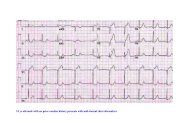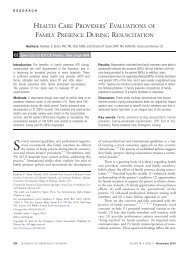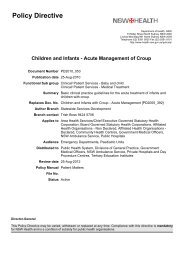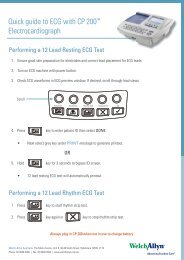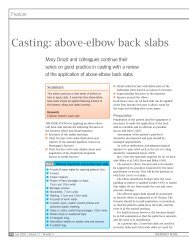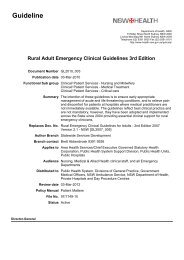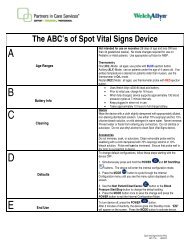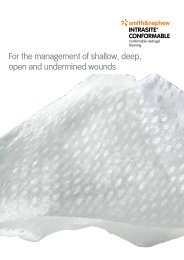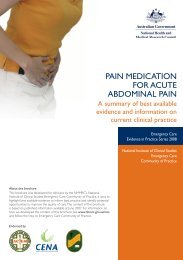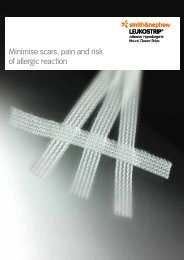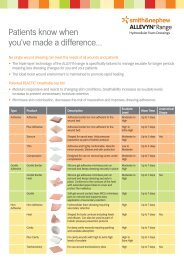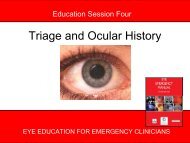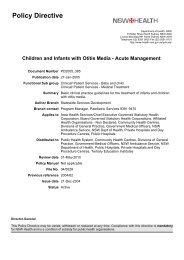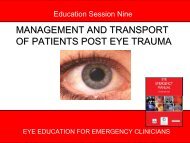Clinical Guidelines for Acute Stroke Management - Living on the EDge
Clinical Guidelines for Acute Stroke Management - Living on the EDge
Clinical Guidelines for Acute Stroke Management - Living on the EDge
Create successful ePaper yourself
Turn your PDF publications into a flip-book with our unique Google optimized e-Paper software.
A notificati<strong>on</strong> system between emergency medical<br />
services staff, emergency department staff and <strong>the</strong><br />
stroke team has also been found to reduce<br />
intrahospital delays and improve patient related<br />
outcomes (those benefiting from receiving<br />
thrombolysis).<br />
39, 83-85<br />
> One n<strong>on</strong>-randomised study reported benefits from<br />
a process of reorganisati<strong>on</strong> of services that included<br />
establishing a nurse led triage team specifically <str<strong>on</strong>g>for</str<strong>on</strong>g><br />
neurological patients, improved prenotificati<strong>on</strong> by<br />
ambulance staff of patients eligible <str<strong>on</strong>g>for</str<strong>on</strong>g> rt-PA, and<br />
introducing a small CT unit within <strong>the</strong> emergency<br />
department <str<strong>on</strong>g>for</str<strong>on</strong>g> priority imaging. 85 While <strong>the</strong><br />
proximity of <strong>the</strong> CT unit was seen as a key<br />
comp<strong>on</strong>ent in this study it is optimistic to c<strong>on</strong>sider<br />
this a feasible strategy <str<strong>on</strong>g>for</str<strong>on</strong>g> most departments.<br />
> Educati<strong>on</strong> of emergency department staff has<br />
also been undertaken as part of a multidimensi<strong>on</strong>al<br />
strategy with improvements noted in processes<br />
of care (<str<strong>on</strong>g>for</str<strong>on</strong>g> example, reduced delays to CT and<br />
increased numbers receiving thrombolysis). 39, 81, 82 19<br />
3.2 TRIAGE IN EMERGENCY DEPARTMENT GRADE LEVEL<br />
a) Diagnosis should be reviewed by a clinician experienced in <strong>the</strong> valuati<strong>on</strong> C Level III-3<br />
of stroke.<br />
108, 111<br />
b) Emergency department staff should use a validated stroke screen tool to C Level II 112<br />
assist in rapid accurate assessment <str<strong>on</strong>g>for</str<strong>on</strong>g> all people with stroke.<br />
c) Local protocols developed jointly by staff from pre hospital emergency D Level III-3 &<br />
services, <strong>the</strong> hospital emergency department and <strong>the</strong> stroke unit should be IV<br />
39, 83, 85<br />
used <str<strong>on</strong>g>for</str<strong>on</strong>g> all people with suspected stroke. Such protocols should include<br />
early notificati<strong>on</strong> by paramedic staff, high priority transportati<strong>on</strong> and triage,<br />
rapid referrals from ED staff to stroke specialists and rapid access to<br />
imaging.<br />
3.3 Imaging<br />
A. Brain imaging<br />
<str<strong>on</strong>g>Stroke</str<strong>on</strong>g> and TIA are clinical diagnoses with brain<br />
imaging available to c<strong>on</strong>firm cerebral ischaemia or<br />
haemorrhage and exclude stroke mimics. One robust<br />
systematic review reported <strong>the</strong> most cost effective<br />
strategy in acute stroke is <str<strong>on</strong>g>for</str<strong>on</strong>g> all patients to undergo<br />
immediate imaging. 100 Recent studies have found that<br />
MRI is more sensitive than CT <str<strong>on</strong>g>for</str<strong>on</strong>g> ischaemic changes<br />
and is as sensitive as CT in identifying acute<br />
haemorrhagic change. 114, 115 CT is sensitive to ICH in<br />
<strong>the</strong> acute phase but not after 8-10 days when MRI<br />
should be used to differentiate ICH and ischaemic<br />
stroke. 100 Thus to c<strong>on</strong>firm diagnosis and differentiate<br />
ICH from ischaemic stroke, MRI is now c<strong>on</strong>sidered <strong>the</strong><br />
imaging strategy of choice. C<strong>on</strong>siderati<strong>on</strong> of several<br />
factors including l<strong>on</strong>ger imaging time and limited<br />
availability of MRI scanners in many centres compared<br />
to CT, however, limits <strong>the</strong> applicati<strong>on</strong> of MRI as a<br />
routine strategy and it is likely that CT will remain<br />
<strong>the</strong> imaging modality of first choice <str<strong>on</strong>g>for</str<strong>on</strong>g> <strong>the</strong><br />
<str<strong>on</strong>g>for</str<strong>on</strong>g>eseeable future.<br />
B. Carotid Imaging<br />
In patients with carotid territory symptoms and where<br />
a large artery disease is suspected, carotid imaging<br />
studies should be per<str<strong>on</strong>g>for</str<strong>on</strong>g>med. A recent robust<br />
systematic review comparing n<strong>on</strong> invasive tests to<br />
c<strong>on</strong>venti<strong>on</strong>al intra arterial angiography found that n<strong>on</strong><br />
invasive methods provide good accuracy, in particular<br />
c<strong>on</strong>trast enhanced magnetic res<strong>on</strong>ance angiography<br />
(CEMRA), in patients with 70-99% stenosis. O<strong>the</strong>r<br />
methods (Doppler ultrasound, Magnetic Res<strong>on</strong>ance<br />
angiography, Computed Tomography Angiography)<br />
were found to be less accurate than CEMRA but still<br />
reas<strong>on</strong>ably good with CTA found to have <strong>the</strong> lowest<br />
accuracy. 102 It was noted that CEMRA is a relatively<br />
new test and not all patients would have access to<br />
Secti<strong>on</strong> 3 Early Assessment and Diagnosis



